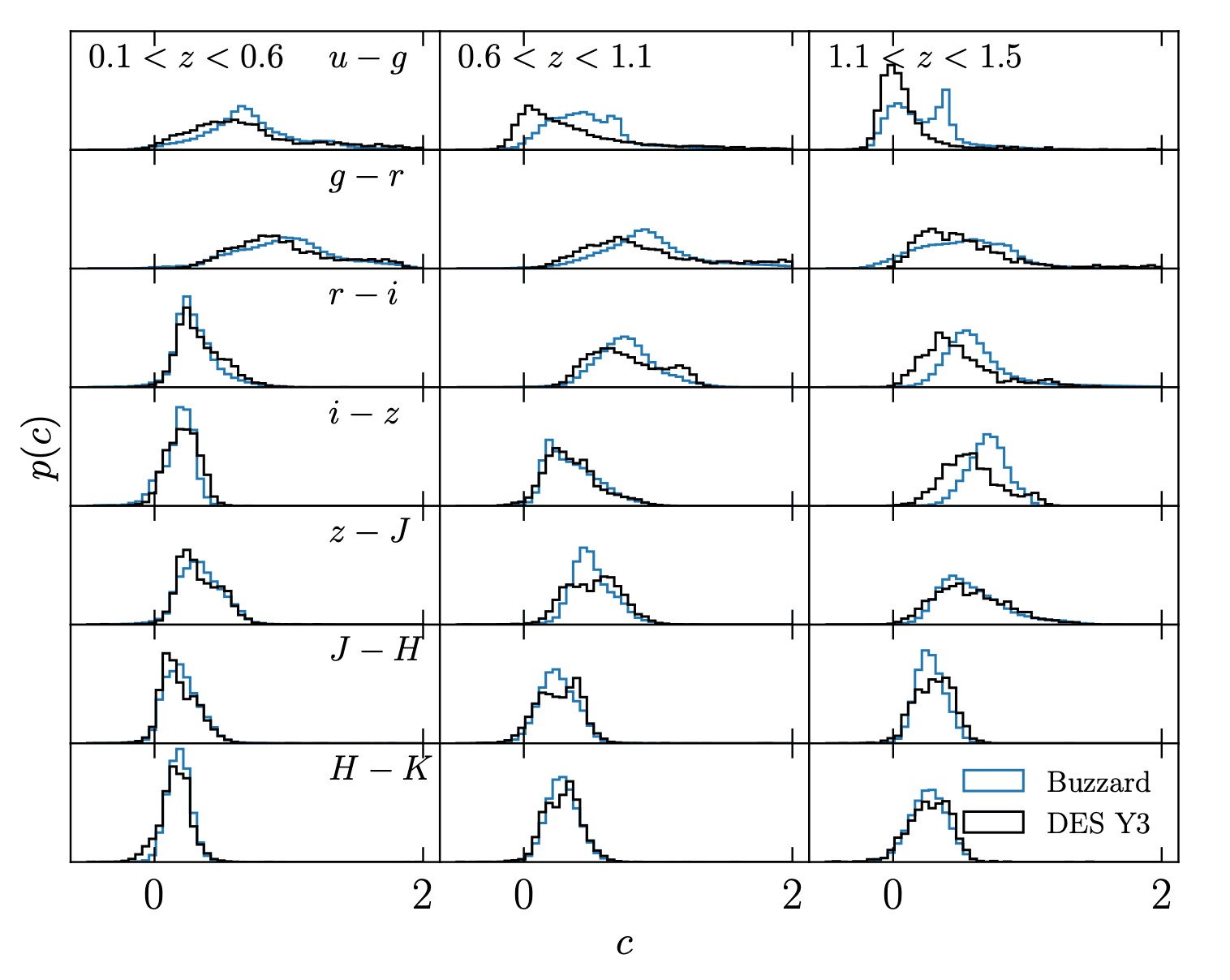Buzzard
Buzzard
Description
The Buzzard catalog is a new suite of cosmological simulations that is tailored for the testing and validation of combined galaxy clustering and weak-lensing analyses. Buzzard DR1 accurately reproduces many important aspects of the Dark Energy Survey Year 3 (DES Y3) data, including photometric redshift and magnitude distributions, and the relevant set of two-point clustering and weak-lensing statistics.
The simulation spans one quarter of the sky extending to z=2.3, and is complete out to that redshift to r=27 as described in DeRose et al. 2019 and DeRose et al. 2022. Given its large area and realism, it is ideal for simulated studies of large scale structure observables, and has been used in a number of analyses in DES, DESI, and the Rubin Observatory, among others. In order to facilitate simulated analyses of existing and upcoming large scale structure surveys, we provide photometry in DECam (ugrizY), VISTA (zYJHKs), WISE (W1, W2), Rubin (ugrizY), and Roman (YJHK) passbands.
Galaxies contain lensed and un-lensed magnitudes, positions, and ellipticities. SEDs are represented with KCORRECT coefficients.
We are publicly releasing one of a set of nine catalogs. The unreleased catalogs are the same in every respect, but are built on lightcones simulated with different initial seeds. Access to these additional catalogs is available upon request to the catalog creators (Joe DeRose: jderose@lbl.gov). In the future, we also expect to release DES and DESI specific catalogs, with galaxy samples selected specific to those surveys, such as redMaGiC and redMaPPer for DES and the four main survey galaxy target classes for DESI.
Column descriptions for the buzzard_dr1.main table at Astro Data Lab are available through our table browser. We add the following columns for convenience: htm9, nest4096, ring256, random_id, elon, elat, glon, glat.

Figure: Comparison of ugrizJHK color distributions as a function of redshift between Buzzard (blue) and the DES Y3 redshift sample (black). Different rows depict color distributions for different band combinations (listed in left column), while different columns show different redshift bins. Agreement is good, except for in the u-band and at redshifts z > 1, where the SED templates used in Buzzard are poorly constrained by data. Figure credit: DeRose et al. 2022.
Data Releases
Buzzard DR1
The Buzzard DR1 table contains a simulated galaxy catalog with positions, velocities, Spectral Energy Distributions (SEDs), broad-band photometry in a number of relevant passbands, weak-lensing shear and convergence, half-light radii, and ellipticities. The galaxy catalog was generated using the ADDGALS algorithm, with ray-traced weak-lensing statistics computed via CALCLENS (see their GitHub page). The underlying cosmological lightcone simulations were run using GADGET-2.
| Buzzard DR1 Summary | |
|---|---|
| Number of objects | 3,075,827,818 |
| Number of columns | 107 |
| Area covered | 10,316 deg² |
| Bands | DECam: u, g, r, i, z, Y; Roman: Y, J, H, K; Rubin: u, g, r, i, z, Y; VISTA: Z, Y, J, H, Ks; WISE: W1, W2 |
Data Access
The Buzzard data are accessible through several means:
Data Lab Table Access Protocol (TAP) service
TAP provides a convenient access layer for the Buzzard catalog database table. TAP-aware clients (such as TOPCAT) can point to https://datalab.noirlab.edu/tap, select the buzzard_dr1 database, and see the database table and descriptions. You can also view the Buzzard tables and descriptions in the Data Lab table browser.
Data Lab Query Client
The Query Client is available as part of the Data Lab software distribution. The Query Client provides a Python API to Data Lab database services. These services include anonymous and authenticated access through synchronous or asynchronous queries of the catalog made directly to the database. Additional Data Lab services for registered users include personal database storage and storage through the Data Lab VOSpace.
The Query Client can be called from a Jupyter Notebook on the Data Lab Notebook server. Example notebooks are provided to users upon creation of their user account (register here), and are also available to browse on GitHub at https://github.com/astro-datalab/notebooks-latest.
